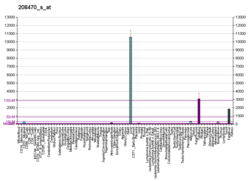Further reading
- Erickson LM, Kim HS, Maeda N (1993). "Junctions between genes in the haptoglobin gene cluster of primates". Genomics. 14 (4): 948–58. doi:10.1016/S0888-7543(05)80116-8. PMID 1478675.
- Maeda N, McEvoy SM, Harris HF, et al. (1986). "Polymorphisms in the human haptoglobin gene cluster: chromosomes with multiple haptoglobin-related (Hpr) genes". Proc. Natl. Acad. Sci. U.S.A. 83 (19): 7395–9. doi:10.1073/pnas.83.19.7395. PMC 386724. PMID 2876426.
- Bensi G, Raugei G, Klefenz H, Cortese R (1985). "Structure and expression of the human haptoglobin locus". EMBO J. 4 (1): 119–26. PMC 554159. PMID 4018023.
- Hillier LD, Lennon G, Becker M, et al. (1997). "Generation and analysis of 280,000 human expressed sequence tags". Genome Res. 6 (9): 807–28. doi:10.1101/gr.6.9.807. PMID 8889549.
- Tabak S, Lev A, Valansi C, et al. (1997). "Transcriptionally active haptoglobin-related (Hpr) gene in hepatoma G2 and leukemia molt-4 cells". DNA Cell Biol. 15 (11): 1001–7. doi:10.1089/dna.1996.15.1001. PMID 8945641.
- Muranjan M, Nussenzweig V, Tomlinson S (1998). "Characterization of the human serum trypanosome toxin, haptoglobin-related protein". J. Biol. Chem. 273 (7): 3884–7. doi:10.1074/jbc.273.7.3884. PMID 9461571.
- Raper J, Fung R, Ghiso J, et al. (1999). "Characterization of a novel trypanosome lytic factor from human serum". Infect. Immun. 67 (4): 1910–6. PMC 96545. PMID 10085035.
- Loftus BJ, Kim UJ, Sneddon VP, et al. (1999). "Genome duplications and other features in 12 Mb of DNA sequence from human chromosome 16p and 16q". Genomics. 60 (3): 295–308. doi:10.1006/geno.1999.5927. PMID 10493829.
- Xu XR, Huang J, Xu ZG, et al. (2002). "Insight into hepatocellular carcinogenesis at transcriptome level by comparing gene expression profiles of hepatocellular carcinoma with those of corresponding noncancerous liver". Proc. Natl. Acad. Sci. U.S.A. 98 (26): 15089–94. doi:10.1073/pnas.241522398. PMC 64988. PMID 11752456.
- Hatada S, Seed JR, Barker C, et al. (2002). "No trypanosome lytic activity in the sera of mice producing human haptoglobin-related protein". Mol. Biochem. Parasitol. 119 (2): 291–4. doi:10.1016/S0166-6851(01)00420-0. PMID 11814582.
- Vanhollebeke B, Nielsen MJ, Watanabe Y, et al. (2007). "Distinct roles of haptoglobin-related protein and apolipoprotein L-I in trypanolysis by human serum". Proc. Natl. Acad. Sci. U.S.A. 104 (10): 4118–23. doi:10.1073/pnas.0609902104. PMC 1820718. PMID 17360487.
- Widener J, Nielsen MJ, Shiflett A, et al. (2007). "Hemoglobin is a co-factor of human trypanosome lytic factor". PLoS Pathog. 3 (9): 1250–61. doi:10.1371/journal.ppat.0030129. PMC 1971115. PMID 17845074.



